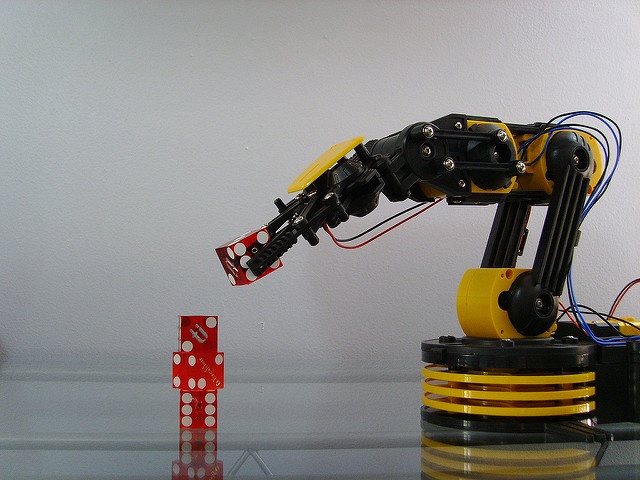Share at:


Editor's note: this article was published in 2016. For a more up-to-date article on this topic, read our 2020 article Why RPA Will Not Destroy Jobs. For a deeper dive, claim your complimentary copy of the e-book Why a Robot Will Be The Best Thing to Happen to Your Career.
If you want to truly examine how robotic process automation (RPA) is changing the way in which the world works, you need look no further than the IT sector. As a burgeoning industry itself, IT is perhaps the first wave of industries in which RPA is thought be eliminating jobs - unjustly so. By automating repetitive and high volume business activities such as order processing or copy-paste tasks, RPA allows businesses to leverage the benefits of increased productivity and efficiency by freeing time for employees to focus on value-adding activities, such as those that involve direct interaction with clients or optimization of inefficient business processes.
For these reasons, it’s been suggested the abilities of RPA give the technology the potential to eventually replace the human workforce, IT jobs in particular. But leading experts tend to dismiss the topic of job displacement within the IT industry as well as in other fields, and the widespread consensus is that replacement of humans employees by robots is not the case.
In point of actual fact, RPA has the ability to create jobs that specifically allow employees to focus on higher value tasks. The proliferation of this technology can carve new careers for those looking to enter the IT industry, and rather than taking away jobs in IT, RPA provides novel and interesting pathways for job opportunities. To illustrate this, we’ll discuss what these new positions might look like within the IT sector, the ways in which they can emerge, and what this evolution means for the future of the workforce.
New Jobs on the Horizon
Yes, it’s possible automation software like RPA might eliminate some jobs, but it’s much more likely RPA will result in a restructuring of the global workforce in which new opportunities for careers are presented. For example, take an article titled “Four Fundamentals of Workforce Automation,” McKinsey suggests that “fewer than 5 percent of occupations can be entirely automated using current technology. However, about 60 percent of occupations could have 30 percent or more of their constituent activities automated…[Automation] will necessitate significant job redefinition and a transformation of business processes.”
RPA is less focused on displacing workers or causing companies to downsize; instead, the automation of menial and time-consuming activities allows companies to shift their focus to more meaningful front office and client-facing activities. In addition, the development and maintenance of RPA technology will itself provide new job opportunities.
In their primer to RPA, the Institute for Robotic Process Automation predicts that “Though it is expected that automation software will replace up to 140 million full-time employees worldwide by the year 2025, many high-quality jobs will be created for those who are able to maintain and improve RPA software.”
As you can see, RPA still - and most likely will in the future - require external support in order to be deployed and sustained within an organization. Specific individuals will be tasked with implementing the technology within a company and managing it to promote successful business outcomes. These new roles and teams will perform changes to workflows to ensure they are optimized and fully-aligned with organizational initiatives and benchmarks.
Occupational Impact of RPA
As the use of RPA increases, so too does the prevalence of reshoring. Outsourcing and offshoring is common within the IT industry, and due to the impact of RPA, the sector is also one where reshoring is predicted to occur more frequently. RPA provides companies with the ability to backshore some of their work, meaning that business activities are no longer executed offshore by BPO providers but rather by internal employees through the help of RPA.
One major contributing factor for this onshoring is cost reduction, especially as guaranteed by automation technologies like RPA. Yet, many organizations are turning to reshoring because it can create more jobs within companies that are employing RPA. This process of reshoring further illustrates that RPA does not symbolize the end of the human workforce but encourages its development instead. Within IT, these new positions can allow employees to identify tasks suitable for automation throughout the organization as well as develop new integral applications and interfaces.
Reshoring via RPA has the potential to foster the creation of new jobs and the reallocation of workers internally which allow companies to be in control of their own activities and resources. Employees will no longer be bogged down by back office tasks, but they will have the freedom to enhance their own performance and make meaningful and innovative contributions to their organizations.
More Challenging Roles for Employees
Through the increased efficiency and productivity it provides, RPA supports human employees in pursuing more meaningful and challenging roles. There is a high demand for complex IT services tied to administrative back office activities that often cannot be fulfilled by employees, and RPA can help close this gap.
An RPA expert with Ernst & Young, Martin Weis suggests that positions where employees are concerned with repetitive, manual work experience turn-over on a regular basis, something which could, in fact, be reduced by RPA: “People don’t really stick with these jobs for more than two years...You may need to hire 20 [percent] to 30 percent each year to renew the workforce that is doing these repetitive tasks. RPA could help to reduce this churn and make work more interesting for many people.”
RPA will allow employees to leave tasks like these behind and move up the value chain in IT or in other parts of the business. We have seen how this development is the case within the IT sector through reshoring as well as with the evolution of the RPA specialist role. But this transformation is poised to impact a more widespread range of industries — finance, healthcare, manufacturing, utilities, and more. New positions revealed by RPA implementation may include creative development roles, individualized customer interaction, and complex management positions. RPA deployment will allow the employees that fill these positions within IT to focus on activities, such as application development, which can have lasting impacts on business outcomes.
RPA Adds, Not Subtracts
Rather than being feared as something that will take away jobs or replace humans, RPA can be viewed as a pathway to job creation that will have a positive impact on companies — and their employees. Not only does RPA produce jobs through reshoring and maintenance, but it also reallocates tasks in a way that allows employees to focus on what’s important. RPA should be approached by employees as a tool that will enable them to make the most of their capabilities and by companies as a mechanism through which they will be able to maximize staff productivity and maintain a competitive edge.

Content Developer, Trekk
Get articles from automation experts in your inbox
SubscribeGet articles from automation experts in your inbox
Sign up today and we'll email you the newest articles every week.
Thank you for subscribing!
Thank you for subscribing! Each week, we'll send the best automation blog posts straight to your inbox.



